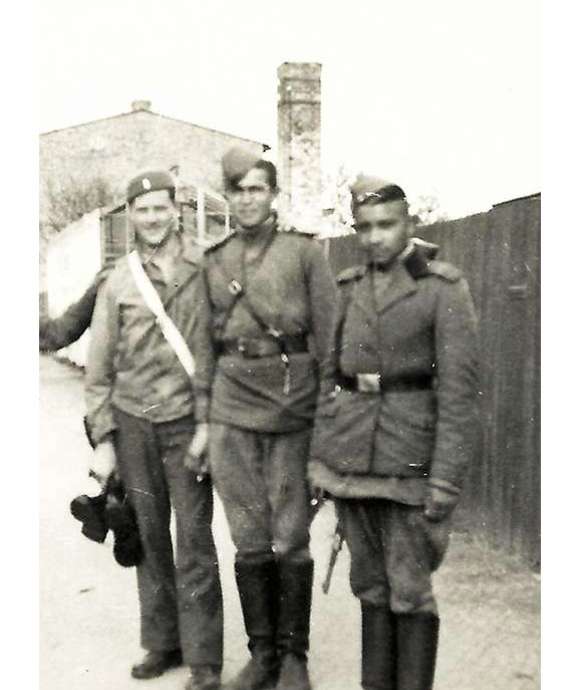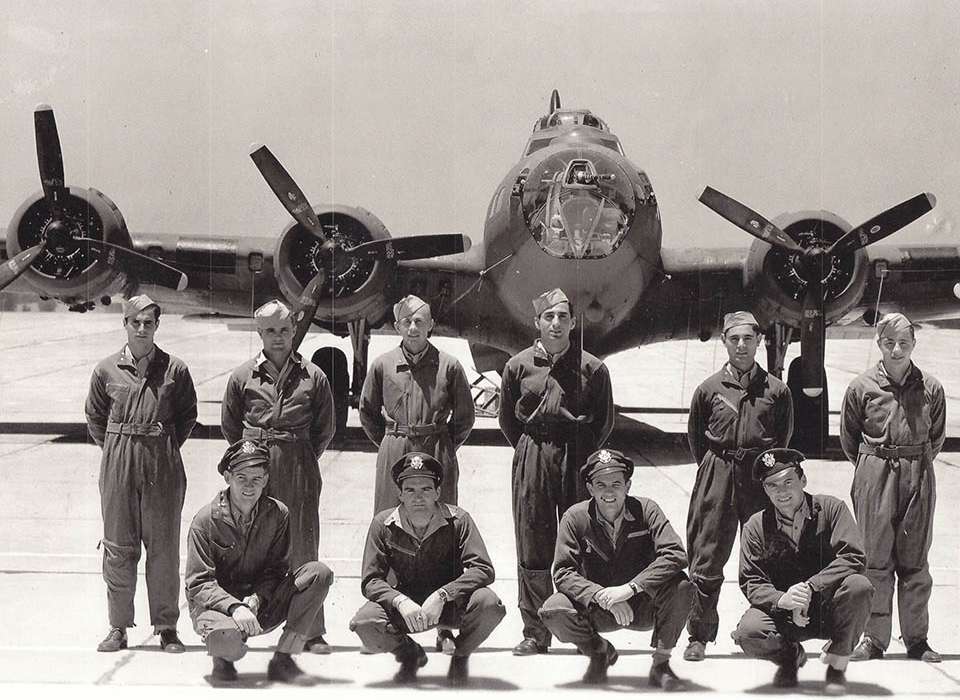Roland Martin was born and raised as a California “Berkeley boy.” Being an excellent baker, his mother was the main supporter of the family. Martin helped out by working as a delivery boy on his bicycle. After graduating from Berkeley High School in 1941, he became a shipfitter helper with the aid of his sister who worked as a secretary at a Henry Kaiser Ship Yard. Although employed, Martin’s true desire was to join the Army Air Corps and fly planes.
In 1942, Martin was accepted into an aviation cadet class and began his training in Santa Ana, California. Unlike the 139 other graduates in his class who dreamed of being fighter pilots, Martin wanted a plane with as many engines as possible. Choosing to be a bomber pilot, Martin was assigned to a Boeing B-17 Flying Fortress and headed to England. Martin joined the 525th Bombardment Squadron, 379th Bombardment Group, 8th Air Force flying the B-17 bomber, the “Iron Maiden.” The airmen’s days were filled with missions targeting industrial sites and marshalling yards with bomb drops in Germany. Martin’s day would start with a mission briefing, followed by taking off and assembling in formation before leaving England and setting a course for Germany. Flying past the coast of Holland, they’d begin to see German fighter planes approach. Fighter attacks and flak were the devils taking them down, and in Martin’s words “it was the luck of the draw whether you were one of the groups being under attack.”
The bomb groups lost planes on nearly every mission. The requirement that each crew member complete 25 missions before returning to the states meant that risking their lives was a daily routine. Due to the high loss rate many of the men flying wouldn’t buddy up to other crews. It was better, when a plane went down, not to have friends who wouldn’t be returning.
Martin completed nine missions and on each one, he witnessed planes plummeting from the sky after being shot down by enemy forces. He commented “we very quickly became fatalistic, if it was gonna happen it was gonna happen.” Having the tremendous responsibility of being the commanding officer, pilots earned the trust of the other nine men aboard the B-17. Being the pilot meant really muscling the airplane around, often a strenuous and mentally engrossing task. On one of those missions Martin recalled landing back in England needing his hands literally to be peeled from the controls they’d frozen to.
On the morning of Martin’s tenth mission, October 14, 1943, the briefing began. They were informed that another run at the Schweinfurt ball bearing factory would be taken; groans sounded around the room. Some of the men had been on the original disastrous run on August 17. Anticipating that the mission would be tough was nothing compared to how the mission actually played out—the high number of casualties sustained would mark this day in history as “Black Thursday.”
The Iron Maiden was downed by flak over the target.
Three bursts of flak exploded right in front of them at their altitude. They were hit, the starboard engines gone. After falling out of formation, another burst of flak hit the port engines; Martin could see gasoline streaming behind them from the shredded wing. The German Ju 88 that had come to see to their demise was shooting at them using tracers which he feared would ignite the gasoline. The Iron Maiden’s bombardier was still in the nose and firing at the oncoming plane while Martin and the copilot were trying to find a workable field in which to land. Training paid off as his sharpened focus found a field as their plane dropped rapidly toward the earth.
The Iron Maiden landed in Germany, in a field full of workers. Martin commented “any landing you can walk away from is a good landing.” The copilot and bombardier immediately took off. Sticking with him, the top turret gunner watched as Martin attempted to burn the airplane by utilizing his sidearm and the puddling gas from the plane.
At this point the German civilians had gathered close to the American spectacle; the downed airmen casually walked through the crowd untouched. Their escape started.
Based on knowledge from books and movies, Martin decided to walk upstream in the water to avoid being tracked. They grabbed hold of an overlying tree limb and pulled themselves into a thicket hoping that their tracks would be undetected by the searchers and their dogs. For two weeks, they were on the run. They used the landscape for cover and tried to get to Switzerland with their compass, map, water purification tablets, and bittersweet chocolate bar as traveling companions.
After two weeks they were captured by a family and turned over to the German military. The two airmen were interrogated, placed in isolation, and put in cattle cars headed to Stalag Luft I. Separated into enlisted and officer groups, Martin was housed with other downed officers caught during the war. He lived on bread and water and the fear that he could be shot at any time. When the POWs were given meat, it was often animals that had been strafed or killed because of their proximity to explosions. The food was as available at Stalag Luft I as it was to the German population. Martin broke a tooth eating deer meat that included pieces of shrapnel.
By May of 1945, the Allied forces had been sweeping through enemy territories with victory; the Russians crossed the upper Oder River north of the camp. The sounds of Allied tanks were coming closer to the POW camp. German guards warned their prisoners not to leave the camp, and then one morning, the guards were gone themselves. Martin and three other officers left Stalag Luft I and ran into the Russian forces.
While Martin and the other liberated POWs waited to be repatriated, the remains of a German slave labor camp were discovered nearby. Martin walked through the barracks watched by the eyes of those emaciated bodies on the bunks covered with lice and so close to death. After leaving the barracks he saw a mass open grave with stacked bodies and two mass grave sites that had already been filled in. Martin said that witnessing this “…sort of hardened me to a great degree, there is a big difference between being involved in killing … [bombing] was my job, we were at war; that killing part was totally separate from the inhumanity [slave labor camp] by the SS.”
The POWs were airlifted in stripped down B-17s to Camp Lucky Strike before they were sent back home to the United States. There they were allowed to eat anything they wanted and Martin liked white bread the most “…it was like angel food cake, it was so good!” Roland Martin took a liberty ship back to the United States with a memorable entrance into the New York Harbor, welcomed by the Statue of Liberty, “the most beautiful thing I had ever seen, it really stands for something.”

The Liberation of Stalag Luft I
When POWs awoke at Stalag Luft I on May 1, 1945, the German guards had disappeared and a hand sewn Stars and Stripes replaced the swastika on the flagpole. The Red Army arrived a day later.
Hannah Dailey
Hannah Dailey has been an Oral Historian at The National WWII Museum since 2015 and has conducted more than 550 oral history interviews to date, several of which are showcased in our permanent galleries.
Cite this article:
MLA Citation:
APA Citation:
Chicago Style Citation:


![Max Fuchs, New York City cantor, sings as Rabbi Sydney [sic] Lefkowitz, Richmond, VA, conducts the first Jewish services from Germany.](/sites/default/files/styles/max_650x650/public/2025-10/image1.jpg)






